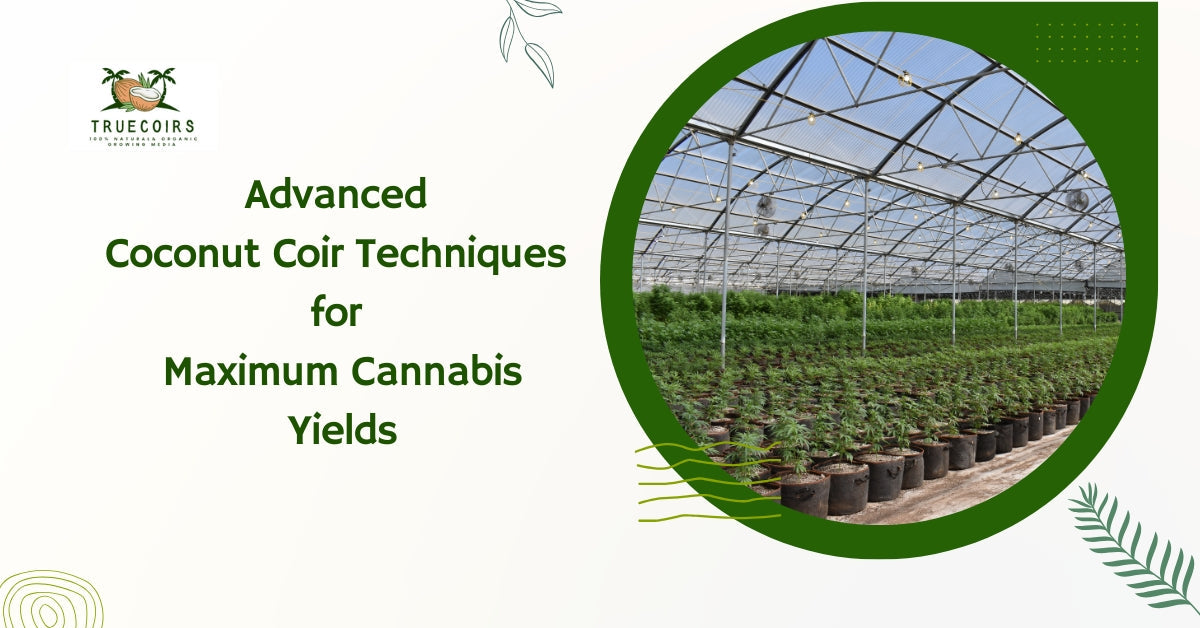Why Elite Cannabis Growers Choose Coco Coir Over Everything Else

You've probably heard coco coir produces bigger yields than soil. But here's what most guides won't tell you: the real advantage isn't the medium—it's the control.
Coco coir gives you hydroponic-level precision with soil-like forgiveness. That means you can push your plants harder, feed them exactly what they need when they need it, and course-correct before small problems become harvest-killing disasters.
This guide is for growers who've already decided on coco coir. We're skipping the basics and going straight into the techniques that separate hobby harvests from commercial-grade results.
Reading Your Plants in Coco Coir: The Signs Most Growers Miss
Growing in coco coir isn't just about following a feed chart—it's about responding to what your plants are telling you.
Overfeeding in Coco Coir (Early Warning Signs)
-
Dark green leaves with clawing tips – Too much nitrogen, especially in early flower
-
Burnt leaf edges despite proper pH – EC buildup in the medium, flush with 50% strength solution
-
Slow vertical growth but thick stems – Excessive potassium, scale back bloom boosters
Underfeeding in Coco Coir (What to Watch For)
-
Pale new growth with dark old leaves – Not enough nitrogen, increase base nutrients by 10-15%
-
Purple stems with slow flowering – Phosphorus deficiency, check pH and increase PK
-
Yellowing from bottom up after week 3 flower – Normal fade or mobile nutrient lockout? Check runoff EC
Pro Tip: In coco coir, deficiencies appear faster than in soil (2-3 days vs. 7-10 days) because there's no nutrient buffer. This is actually an advantage—you can correct issues before they impact yield.
The Cannabis Grower's Feeding Schedule for Coco Coir
This isn't a rigid formula—it's a framework. Adjust based on strain, environment, and plant response.
Seedling Stage (Days 1-14)
-
EC: 0.4-0.6 (200-300 PPM)
-
pH: 5.8-6.0
-
Frequency: Every other day, light watering
Note: Seedlings don't need much. Overwatering in coco coir during this phase is the #1 killer.
Vegetative Stage (Weeks 2-6)
-
EC: 1.0-1.4 (500-700 PPM)
-
pH: 5.8-6.2
-
Frequency: Daily feeding to 10-20% runoff
-
Cal-Mag: 3-5ml per gallon with every feeding
-
Tip: Increase EC by 0.1-0.2 weekly as plants establish. Sativas can handle lower EC than indicas.
Early Flower (Weeks 1-3)
-
EC: 1.4-1.8 (700-900 PPM)
-
pH: 6.0-6.2
-
Frequency: Daily, increase to 20% runoff to prevent salt buildup
-
Transition: Gradually shift from grow to bloom nutrients over 7-10 days
Mid to Late Flower (Weeks 4-8)
-
EC: 1.6-2.0 (800-1000 PPM)
-
pH: 5.9-6.1
-
Frequency: Daily, maintain 20% runoff
-
Peak Feeding: Weeks 4-6 are your highest nutrient demand period
-
Note: Some cultivars can't handle EC above 1.8—watch for tip burn
Pre-Harvest Flush (Final 7-10 Days)
-
EC: 0.0-0.2 (pure water or flushing solution)
-
pH: 6.0-6.5
-
Goal: Remove residual salts for cleaner flavor and smoother smoke
Strain-Specific Coco Coir Adjustments
Not all cannabis is the same. Here's how to modify your approach:
Heavy Feeders (OG Kush, Gelato, GSC)
-
Can handle EC up to 2.2 in peak flower
-
Require aggressive Cal-Mag supplementation
-
Benefit from additional silica for structural support
Light Feeders (Landrace Sativas, Haze varieties)
-
Keep EC below 1.6 throughout flower
-
More sensitive to nitrogen—reduce by 15-20% after stretch
-
Longer flower time means extended feeding window
Auto-Flowering Strains
-
Compress the entire feeding schedule into 8-10 weeks
-
Lower EC across all stages (0.8-1.4 max)
-
Never flush longer than 5 days—you'll sacrifice yield
Automated Watering in Coco Coir: Beyond the Drip System
Automation isn't just convenience—it's consistency. And in coco coir, consistency = bigger yields.
What You Actually Need
-
Irrigation controller with multiple feed times per day
-
Individual drip stakes (1-2 per plant depending on pot size)
-
Runoff collection system or drain-to-waste setup
-
Inline filter to prevent clogging from organic additives
Optimal Feeding Frequency
-
Small pots (1-3 gal): 2-3x daily
-
Medium pots (5-7 gal): 1-2x daily
-
Large pots (10+ gal): Once daily or every other day
The Science: Frequent, smaller feedings keep the root zone consistently moist without waterlogging. This maximizes oxygen exposure and nutrient uptake—the secret to explosive root development.
Reusing Coco Coir: The Right Way
You can reuse coco coir for 3-4 cycles if you treat it properly. Here's the protocol commercial growers use:
Post-Harvest Treatment
-
Remove root mass – Pull out as much as possible by hand
-
Enzyme flush – Soak in enzymatic solution (Cannazym, Hygrozyme) for 24 hours
-
Heavy rinse – Flush with 3x the volume of the medium in clean water
-
Rebuffer – Treat with Cal-Mag solution at 3ml/gal, let sit for 12 hours
-
Final rinse – Check EC of runoff (should be below 0.4)
When to Retire Coco Coir
-
After 3-4 cycles, the fiber breaks down and water retention increases
-
If you see fungus gnats or root aphids, don't risk it—discard
-
Consider composting old coco coir rather than landfilling it
Coco Coir + Living Soil Hybrids: Best of Both Worlds?
Some growers are experimenting with coco coir-based "super mixes" that combine synthetic precision with organic complexity.
The 60/30/10 Mix
-
60% buffered coco coir
-
30% perlite
-
10% worm castings or compost
Benefits:
-
Better water retention than pure coco coir
-
Slow-release organic matter
-
Supports beneficial microbes
Drawbacks:
-
Requires different feeding approach (hybrid organic/synthetic)
-
Harder to read EC/pH accurately
-
Not recommended for automated systems
Troubleshooting Common Coco Coir + Cannabis Issues
Problem: Yellowing Lower Leaves in Early Flower
Cause: Either nitrogen deficiency or natural fade starting too early
Fix: Check runoff EC. If below 1.4, increase base nutrients. If above 1.8, you're overfeeding and locking out nitrogen—flush and reduce feeding strength.
Problem: Slow Growth Despite Perfect Environment
Cause: Root zone issues—either overwatering, underwatering, or poor aeration
Fix: Check pot weight. Coco Coir should dry to 50% between waterings. If consistently heavy, add more perlite next run. If bone dry, increase watering frequency.
Problem: Random Deficiencies That Don't Respond to Feeding
Cause: pH fluctuation or unbuffered coco coir still binding nutrients
Fix: Check pH of both input solution and runoff. If runoff is 0.5+ points different from input, your coco coir isn't properly buffered. Flush and rebuffer with Cal-Mag.
Environmental Adjustments for Coco Coir Growing
Coco Coir dries faster than soil, which affects your entire growing environment.
VPD (Vapor Pressure Deficit) Considerations
-
Veg: Target 0.8-1.0 kPa
-
Flower: Target 1.2-1.5 kPa
-
Because coco coir roots have constant moisture access, you can push higher VPD without stress
Temperature & Humidity
-
Lights On: 75-82°F (24-28°C)
-
Lights Off: 65-72°F (18-22°C)
-
Humidity: 60-70% (veg), 45-55% (flower)
-
Coco's superior drainage reduces mold risk, allowing slightly higher humidity than soil
The Yield Difference: Real Numbers
Based on side-by-side grows with the same genetics:
Soil:
-
Average yield: 400-500g per 1000W
-
Harvest window: 8-10 weeks flower
Coco Coir (optimized feeding):
-
Average yield: 520-650g per 1000W
-
Harvest window: 8-9 weeks flower
Why the difference?
-
Faster vegetative growth (7-10 days shorter to flip)
-
Denser root mass = more nutrient uptake
-
Ability to push plants harder without root stress
-
Better consistency plant-to-plant
Final Thoughts: Mastery Takes Time
Coco coir isn't magic. But it rewards growers who pay attention, take notes, and adjust based on what they observe.
Your first run in coco coir might match your soil yields. Your third run? You'll wonder why you didn't switch sooner.
The key: Treat coco coir like hydroponics with training wheels. Give your plants what they need, when they need it, and let the medium do the rest.
Ready to dial in your coco coir grow? Start with quality, lab-tested coco coir from TrueCoirs and spend less time troubleshooting, more time harvesting.
